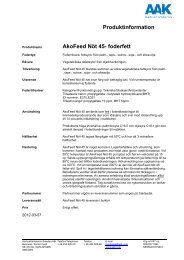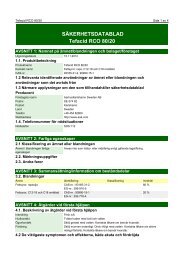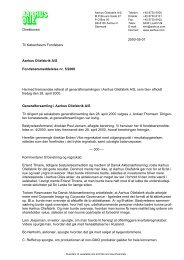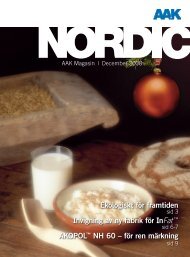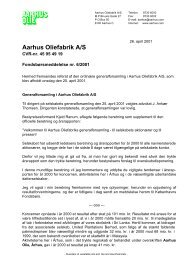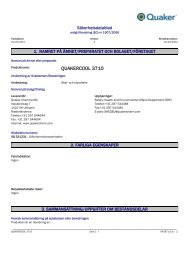Beat Migration Bloom on Chocolate Products by Optimizing ... - AAK
Beat Migration Bloom on Chocolate Products by Optimizing ... - AAK
Beat Migration Bloom on Chocolate Products by Optimizing ... - AAK
Create successful ePaper yourself
Turn your PDF publications into a flip-book with our unique Google optimized e-Paper software.
<str<strong>on</strong>g>Beat</str<strong>on</strong>g> <str<strong>on</strong>g>Migrati<strong>on</strong></str<strong>on</strong>g> <str<strong>on</strong>g>Bloom</str<strong>on</strong>g> <strong>by</strong> <strong>Optimizing</strong> Your Process<br />
Why do these<br />
special heat or<br />
cooling treatments<br />
sometimes improve<br />
bloom stability in<br />
filled products?<br />
In general, it is a<br />
questi<strong>on</strong> of compensating<br />
for some<br />
defects in the<br />
basic producti<strong>on</strong>.<br />
DSC Peak Values<br />
Peak values<br />
Figure 4<br />
33.5<br />
33.4<br />
33.3<br />
33.2<br />
33.1<br />
33.0<br />
32.9<br />
32.8<br />
32.7<br />
32.6<br />
32.5<br />
Figure 2 shows that when making a temper<br />
test at a low cooling temperature the same<br />
chocolate would be undertempered if it had<br />
been measured at a higher cooling tempera-<br />
ture, which actually is more similar to the tem-<br />
perature used in producti<strong>on</strong> lines.<br />
The lower the cooling temperature, the lower<br />
the inflecti<strong>on</strong> point, see Figure 3.The <strong>on</strong>ly ex-<br />
planati<strong>on</strong> for this kind of lower inflecti<strong>on</strong> point<br />
for the same chocolate and lower values for<br />
dsc peak (Figure 4) must be the different ratio<br />
between Forms IV and V in the final chocolate<br />
samples. The more the cooling, the more Form<br />
IV crystals are generated in the final chocolate.<br />
Pure Form IV crystals are very unstable and<br />
for that reas<strong>on</strong> they will quickly transform into<br />
Form V depending <strong>on</strong> fat compositi<strong>on</strong> and tem-<br />
Peak value Linear (Peak value)<br />
y = 0.0622x = 32.17<br />
R² = 0.92<br />
7 9 11 13 15 17 19<br />
Cooling temperature °C<br />
Cooling Rates vs. Melting Peak Values<br />
Cooling Peak value °C<br />
Rates melting curve<br />
28°C –> 15°C 32.3<br />
Rate 0.3°C/min<br />
10 min at 15°C<br />
15°C –> 60°C with 5°C/min<br />
28°C –> 15°C 32.0<br />
Rate 0.5°C/min<br />
10 min at 15°C<br />
15°C –> 60°C with 5°C/min<br />
28°C –> 15°C 31.6<br />
Rate 1.5°C/min<br />
10 min at 15°C<br />
15°C –> 60°C with 5°C/min<br />
Figure 5<br />
4 May 2010 • Reprint from The Manufacturing C<strong>on</strong>fecti<strong>on</strong>er<br />
perature. Smaller amounts of Form IV crystals<br />
in mixtures with a lot of Form V will probably<br />
make the chocolate unstable, too, but how<br />
much probably depends <strong>on</strong> the ratio between<br />
the two polymorphs and the above-menti<strong>on</strong>ed<br />
factors. Nobody knows how much Form IV<br />
“c<strong>on</strong>taminati<strong>on</strong>” you can have in a chocolate<br />
without influencing c<strong>on</strong>tracti<strong>on</strong>, gloss, etc.<br />
Figure 5 shows a well-tempered dark choco-<br />
late cooled <strong>on</strong> a dsc with three different cooling<br />
rates.<br />
The chocolate is tempered <strong>on</strong> a 50 kg three-<br />
z<strong>on</strong>e tempering unit and a small sample is<br />
weighed into preheated dsc cups and placed in<br />
the dsc equipment. The samples are stored for<br />
2 minutes at 28°C and then cooled with three<br />
different rates to 15°C, kept at 15°C for 10 min-<br />
utes and then remelted at 5°C/min from 15°C<br />
to 60°C. The different values for the melting<br />
peaks are shown in Figure 5.<br />
These results show the same tendency as<br />
seen from the results menti<strong>on</strong>ed in Figures 3<br />
and 4.<br />
The faster the cooling, the lower the peak value<br />
and the wider the melting curves.<br />
SPECIAL HEAT OR COOLING<br />
TREATMENT<br />
Individual companies sometimes use different<br />
types of special treatment to optimize bloom<br />
stability. Some store in cool c<strong>on</strong>diti<strong>on</strong>s for a<br />
week or more, others store in hot c<strong>on</strong>diti<strong>on</strong>s for<br />
a few days up to <strong>on</strong>e week.<br />
Why do these special heat treatments or<br />
special cooling treatments sometimes improve<br />
bloom stability in filled products? And why is<br />
this effect different from applicati<strong>on</strong> to applica-<br />
ti<strong>on</strong> and time to time?<br />
In general, it is a questi<strong>on</strong> of compensating<br />
for some defects in the basic producti<strong>on</strong>. It<br />
seems that a heat treatment compensates for






